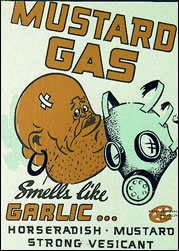Russia has to deal with the need to destroy a chemical weapon based on mustard gas - and it is doing it using a common Pseudomonas bacterium

Russia has to deal with the need to destroy a chemical weapon based on mustard gas - and it does so using a common Pseudomonas type bacterium.
The Russians will have to destroy, according to an agreement they signed with the USA, no less than 40 thousand tons of these chemical substances intended to be used in its chemical weapons. This is the world's largest stockpile of chemical weapons components - and they will have to be completely destroyed by 2007, when the destruction procedure must be very careful, so as not to cause an ecological disaster.
A Russian eradicator team led by D'Ina Yaramkova from the Institute of Biochemistry and Physiology of Microorganisms, began testing the possibility of recruiting the Pseudomonas bacterium to eliminate the chemical weapon. The bacterium is supposed to digest the toxic by-products that will be created in the destruction process. This is because when the mustard gas is destroyed in a chain of chemical reactions, the same toxins appear, when the process includes burning to create asphalt, it is too complex and expensive and also endangers the environment.
Mustard gas is the component that causes leprosy (bubbles on the surface of the skin) and was used in the chemical weapons used in the First World War. It exists in the form of liquid and particles that are dispersed in the air (aerosols). Its damage causes severe burns, severe damage to internal organs, the respiratory system. 2% of the entire Russian chemical weapons stockpile is based on mustard gas and 60% of the mustard gas during the burning process will produce toxic components.
The Russian researchers educated a bacterium and helped it grow using chemicals such as mono-ethanolamine and ethylene glycol. So that when the bacterium grows - it will start devouring the toxic by-products from the process of burning the mustard gas that was done in the chemical mass reaction. As long as the bacterium grows, the proportion of I wish products will decrease. It is therefore a biotechnological method that is safe for the environment and the soil.
